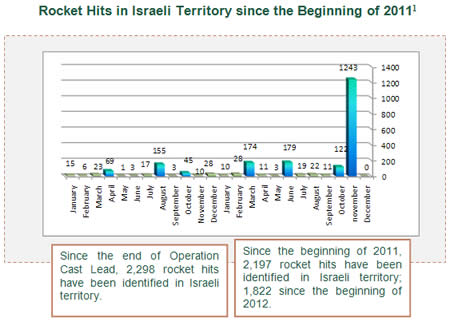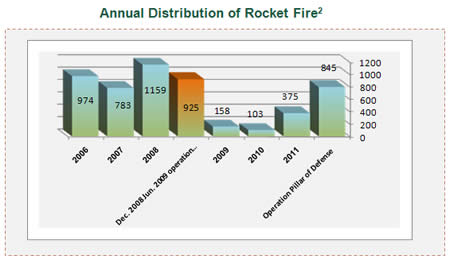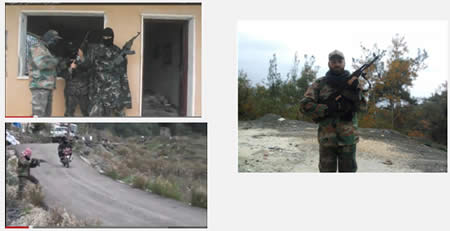- Israel’s south remains quiet. Since the end of Operation Pillar of Defense no rockets or mortar shells fired from the Gaza Strip have hit Israeli territory. Violence continues to rise in Judea and Samaria (stones and an IED thrown at Israeli security forces).
- Fatah held events to mark the 48th anniversary of its founding, stressing the upgrading in the Palestinian Authority’s status in the UN General Assembly. The main rallies in Judea and Samaria were held in Bethlehem and Ramallah. After endless haggling, Hamas in the Gaza Strip allowed Fatah to hold a rally in the Al-Saraya Square in Gaza City, but rejected the Fatah request to hold a march through the Al-Katiba Square, which is larger and can accommodate a greater number of participants.
- Hamas and the other terrorist organizations in the Gaza Strip continue to implement the understandings reached at the end of Operation Pillar of Defense. Since 2300 hours on November 21 no rockets or mortar shells hit Israeli territory.


The Wave of Violence in Judea and Samaria Continues
- This past week as well Palestinians continued to attack IDF soldiers, a manifestation of the trend towards an increase in violence in Judea and Samaria since Operation Pillar of Defense, and especially since the UN status of the PA was upgraded. There has been an increase in the number of stones and Molotov cocktails thrown, as well as attempts to attack Israeli security force personnel. Some of the more glaring incidents were the following (Ynet):
- On December 27 a homemade bomb was thrown at Israeli security forces near the Tomb of Rachel (Bethlehem). The explosive device fell in territory under Palestinian control. There were no casualties and no damage was reported. Dozens of Palestinians also threw stones at the Tomb precinct.
- On December 27 stones were thrown at the vehicle of an Israeli security officer near the Horasha outpost (northwest of Ramallah). IDF soldiers responded by employing riot control equipment.
- On December 27 Palestinian rioters threw stones at IDF forces in the region of Izhar (south of Nablus) and near the Esh Kodesh outpost. IDF soldiers dispersed them with riot control equipment.
- On December 29 a Palestinian in the village of Beit Umar (southern Judea) threw a large stone during a demonstration, wounding an IDF officer in the head. The officer was evacuated to a hospital for medical treatment. The Palestinian who threw the stone was later detained.
Exposure of a Popular Front for the Liberation of Palestine (PFLP) Cell Planning Abductions of Israelis[3]
- In recent months the Israeli security forces exposed a number of Palestinians who belonged to a PFLP cell operating in the region of Ramallah. The cell was headed by two terrorist operatives. Under questioning they admitted that they planned to abduct an IDF soldier to use as a bargaining chip for the release of PFLP secretary general Ahmad Sa'adat, imprisoned in Israel.
- The two cell heads were:
- Ashraf Khalil Mahmoud Abu Aram, born 1986, a resident of Ramallah, founder of the cell.
- Muhammad Anwar Muhammad Zeitoun, born 1986, a resident of Ramallah, recruited by Abu Aram.
- Questioning of the two PFLP terrorist operatives revealed that they planned to distract IDF forces by shooting at them, and then use the distraction to abduct an IDF soldier. They also planned to abduct an Israeli civilian waiting at a bus stop near the village of Jit in Samaria. They planned to drive the victim in a van to a hiding place in the village of Aqab, on the outskirts of Ramallah. The cell operatives also participated in riots and violent "popular" activities against the Israeli security forces.
Hamas Permits Fatah Rally
- Nabil Shaath, a member of the Fatah Central Committee in the Gaza Strip, said that the rally marking the 48th anniversary of the founding of Fatah was expected to be held, but it would take place in the Al-Saraya Square in Gaza City (Safa News Agency, December 30, 2012) and not in the Al-Katiba Square, as Fatah had requested.[4] A compromise was reached with the intervention of Ismail Haniya, who met with representatives of the terrorist organizations after he learned that Fatah was planning to cancel the rally (Qudsnet website. December 30, 2012). The rally will be held on Friday afternoon, January 4, 2013, after the Friday prayer in the mosques (Ma'an News Agency, December 29, 2012).
- When it became known that Hamas had granted permission to hold the rally, Fatah activists took to the streets of Gaza to celebrate (Filastin Al-'An, December 29, 2012). Preparations also began for the rally, and a stage was built for a model of Al-Aqsa mosque. About 5,000 participants are expected to join the rally, including members of Central Committee and the PLO’s Revolutionary Council, who will arrive from Judea and Samaria (Ma'an News Agency, December 28, 2012).

Preparations in the Al-Saraya Square for the Fatah rally marking the 48th anniversary of its founding (Qudsnet website. December 30, 2012).
Hamas Terrorist Operative from the Gaza Strip Killed in Syria
- Muhammad Quneita, an Izz al-Din al-Qassam Brigades Hamas terrorist operative from the Al-Shati refugee camp, was killed during confrontations between Syrian regime forces and opposition forces in the region of Idlib in northwestern Syria. According to reports, he joined the "Free Syrian Army" four months ago as an advisor and was mortally wounded in one of the confrontations. In addition, it was reported that Quneita served in one of the Izz al-Din al-Qassam Brigades' special units and was also an officer in the internal security services of the de-facto Hamas administration (UPI, December 28, 2012). Videos were uploaded to YouTube showing him training opposition forces in Syria.

Left: Muhammad Quneita in a Free Syrian Army uniform (Hamas forum website, December 29, 2012). Right: Scenes from the YouTube videos showing him (left) training and advising Free Syrian Army fighters (Filastin Al-'An, December 31, 2012).
The Hamas Administration’s Ministry of the Interior Launches a New Radio Station
- On December 27, 2012, the ministry of the interior of the de-facto Hamas administration launched a new radio station called "Al-Filastiniya" (98 FM). According to an announcement from the ministry, the purpose of the station is to increase security awareness among Gazans and to upgrade the media system (Website of the Hamas ministry of the interior, December 27, 2012). Fathi Hamad, minister of the interior in the Hamas administration, participated in the station’s experimental broadcasts. The new station joins the other Hamas radio stations in the Gaza Strip, including Radio Al-Aqsa (106.7 FM), Radio Al-Resala (online only) and Radio Al-Qur'an al-Karim(98.6 FM).
Contact with the Israeli Media Prohibited
- The Hamas administration also reported that it was prohibiting Palestinian correspondents and media personnel in the Gaza Strip from collaborating with the Israeli media, claiming they "distort the situation in the Gaza Strip and are neither objective nor professional" (Filastin Al-'An, December 25, 2012). According to Ihab al-Ghussein, director of the Hamas administration's information bureau, the decision was made after a study had been conducted, whose results indicated that Palestinian media personnel had been exploited by the Israeli media. Al-Ghussein warned Palestinian media personnel not to violate the prohibition and threatened that legal steps would be taken against anyone who did (Filastin Al-'An, December 26, 2012).
Raising Youngsters in the Gaza Strip to Hate Israel
- The Hamas-affiliated Filastin Al-'An website posted pictures of preparations made by the pre-military educational teams in the schools in the Gaza Strip for an event, the first of its kind, to be held for the heads of the Hamas ministry of education (Filastin Al-'An, December 30, 2012). The pictures show officers responsible for pre-military education walking on Israeli flags during morning parade.
Opening the Rafah Crossing for Building Materials
- Egypt authorized the delivery of approximately 1,000 tons of building materials through the Rafah crossing. They were sent from Qatar as part of the program for rebuilding the Gaza Strip. Since, according to the agreements signed with Israel, the Rafah crossing allows only for human traffic and the delivery of medical equipment, it was decided that the building materials would be delivered in the afternoons (Masrawi website, December 29, 2012). On December 30 the first convoy of 30 trucks entered the Gaza Strip with approximately 1,500 tons of building materials for rebuilding and repaving the main roads.
- Hamas sources expressed satisfaction with the agreement reached with Egypt. They also assured Egypt that it did not mean making Egypt responsible for the Gaza Strip instead of Israel:
- Musa Abu Marzouq, deputy chairman of the Hamas Executive Committee thanked Egypt for permitting the delivery of building materials through the Rafah crossing (Musa Abu Marzouq's Facebook page, December 31, 2012).
- Abd al-Salim Siyyam, secretary general of the Haniya administration praised the Egyptian efforts to ease the Israeli "closure" of the Gaza Strip, calling it "a step in the right direction" (Filastin Al-'An, December 31, 2012).
- Raed Fattouh, in charge of coordinating the entry of goods into the Gaza Strip, reported that 20 trucks of gravel had entered the Gaza Strip from Israel through the Kerem Shalom crossing for the private sector, the first time in six years (Safa News Agency, December 30, 2012).
Foreign Delegations Continue to Visit the Gaza Strip
- Aid delegations from around the globe continue arriving in the Gaza Strip. This past week a delegation of activists organized by the "Welcome to Palestine" campaign of the FrenchEuroPalestine organization entered the Gaza Strip. The delegation had close to 100 participants. According to the members of the delegation, who planned to arrive on the fourth anniversary of Operation Cast Lead, their main objective was allegedly "to break the illegal siege of the Gaza Strip."
- Most of the delegation was French (an estimated 60 activists), but there were also activists from Belgium, the United States, Ireland and 25 from Egypt, joined by a nine-man delegation from Italy. The delegations brought medicines, foodstuffs (mainly candy) and French textbooks. The delegation was headed by Olivia Zemor, a Jewish Frenchwoman, affiliated with the radical left, who is president of the organization. Arriving in the Gaza Strip, she said that she was very emotional and happy because it was the first time a delegation from her organization had succeeded in entering the Palestinian territories (PressTV, December 27, 2012).
- While in the Gaza Strip, the members of the delegation were taken on tours organized by Hamas. They visited the Al-Shifaa hospital and other sites in the Gaza Strip damaged by the IDF during Operation Pillar of Defense. They repeated the Hamas propaganda mantra that the destruction indicated "Israel's desire to damage the civilian infrastructure," particularly criticizing the IDF hit on the Gaza stadium (Europalestine website, December 28, 2012). (Note: The IDF struck weapons stockpiled in the stadium, which served as a launching pad for rockets fired into Israel.) The activists also visited the Islamic University (a Hamas stronghold), the port of Gaza and the monument erected for the Mavi Marmara flotilla (Al-Aqsa TV, December 30, 2012).
- On the afternoon of December 31, members of the EuroPalestine delegation, including the members of the Italian delegation, gathered near the Israeli border security fence (apparently in the central or northern Gaza Strip). They later claimed they had seen the damage done by the IDF and expressed solidarity with local farmers and residents living near the fence. They held a display of defiance (low-key and without provocation) against the so-called "the occupation forces" and using it for a photo-op near the fence (Shihab News Agency and the Freedom Flotilla Italia websites, December 31, 2012).
- A delegation of 29 Australian sheiks and scholars, headed by Dr. Ibrahim Abu Muhammad Salem, the mufti of Australia. They brought medical aid. A 13-man delegation of Tunisians belonging to the Scouts also visited the Gaza Strip (ONE, December 29, 2012).
Events Marking the Anniversary of the Founding of Fatah
- Fatah is marking its 48th anniversary by celebrating its upgrading in the UN with various events in Judea, Samaria and the Gaza Strip. The main rallies were held in the courtyard of the Church of the Nativity in Bethlehem and in Ramallah, where Mahmoud Abbas lit the torch that traditionally opens the events (Ma'an and Wafa News Agencies, December 31, 2012). Rallies and additional events were also held in other cities.
- The events centered around Fatah's formal announcement stating its basic ideology, which includes giving full rights to the Palestinians in their homeland, "Palestine with Jerusalem as its capital." Fatah spokesman Ahmed A'asaf said that this year the anniversary of the founding of Fatah was especially important because it fell shortly after "the historic achievement" of the Palestinian people in the UN General Assembly, where Palestine now had the status of a non-member state (Wafa News Agency, December 30, 2012).
Mahmoud Abbas' Threat to Dismantle the PA and Hamas' Response
- Interviewed by the Israeli daily newspaper Haaretz on December 27, Mahmoud Abbas threatened (not for the first time) he would dismantle the Palestinian Authority and restore responsibility for it to the government of Israel if negotiations were not renewed immediately after Israel's elections (January 22, 2013). Negotiations would be renewed based on familiar Palestinian conditions, among them a freeze on construction in the settlements and the release of Palestinian prisoners detained before the signing of the Oslo Accords. He also said that Israel had to renew the flow of tax revenues into the PA (Ma'an News Agency, December 27, 2012).
- Mahmoud Abbas' remarks were strongly criticized, especially by senior Hamas figures.
- Khalil Abu Laila, a top Hamas official, said that Mahmoud Abbas could not dismantle the PA and he wasn't the one who had established it according to the agreements. He said Mahmoud Abbas could resign but he could not dismantle the PA because it did not have to implement his decisions. He added that if the PA were fully dismantled, including its security services, and ended its coordination with Israel, Israel would find itself confronting the Palestinian people as it had during the first intifada (BBC, December 28, 2012).
- Mahmoud al-Zahar, a member of the Hamas Executive Committee, said that Mahmoud Abbas' threat to dismantle the PA and "give away the keys" was an attempt to drag Israel into negotiations. He said the decision to dismantle the PA could not be taken by Mahmoud Abbas alone and that he had to consult with all the Palestinian factions (Middle East News Agency, December 29, 2012).
- Later, Saeb Erekat, a member of the PLO's Executive Committee, denied that Mahmoud Abbas had threatened to dismantle the PA. He explained that Israel had bled the PA of its authority and turned it into "an authority without authority." He added that Mahmoud Abbas had said that the PA would not be able to continue holding negotiations with Israel if Israel continued resisting the freeze on construction in the settlements and did not release the prisoners (Al-Hayat Al-Jadeeda and Al-Quds Al-Arabi, December 29, 2012).
[1] As of January 1, 2013. The statistics do not include mortar shell fire.
[2] The statistics for 2008 and 2009 include rocket hits identified during Operation Cast Lead. They do not include mortar shell fire.
[3] According to the Israeli Security Agency website.
[4] The Al-Saraya Square is smaller than the Al-Katiba Square and cannot accommodate as many demonstrators.













